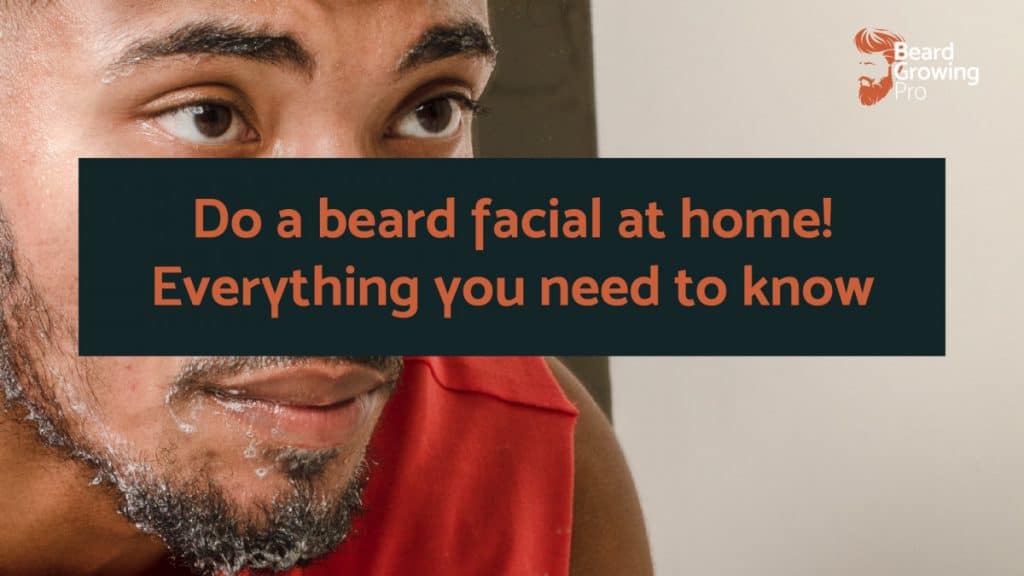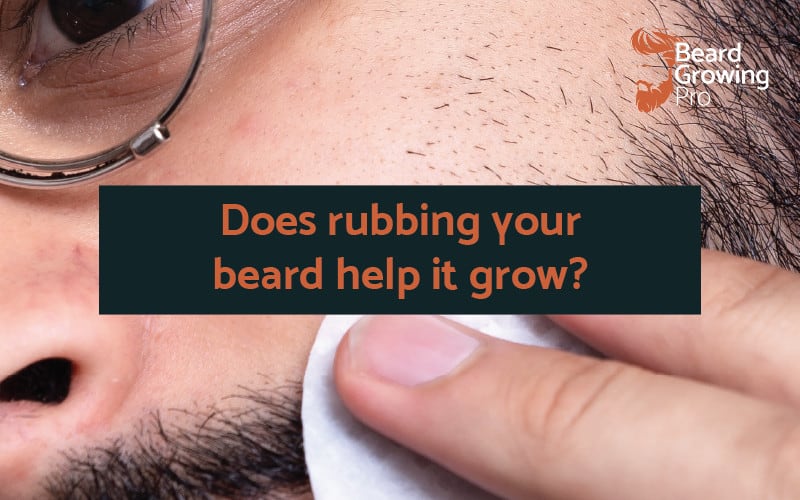Rubbing your beard has been reported to provide some benefits for its growth. From increased stimulation and exfoliating the skin, rubbing your beard regularly could make it better. But how true is that? This article will look at whether or not rubbing your beard will help it grow and look at the science behind facial massaging and hair growth.
Rubbing your beard will not help your beard grow faster or thicker. There is a marginal amount of improved circulation through rubbing, but you risk twisting the beard hairs and damaging the roots of the hairs through vigorous massage.
I have been growing my beard for three years, and it has been my diet, exercise, and overall health which has helped my body grow a thick and full beard. Some science suggests that massage and physical manipulation of the skin can help stimulate circulation and release hormones for relaxation.
For some people, the act of rubbing their beard maybe for comfort rather than growth. Gently massaging your face may allow you to relax, focus on something else for a while, and escape the daily grind. That may not cause your beard to grow faster but may help your overall health and well-being.
I delved into the literature to find out what the potential benefits of rubbing your beard could be.
Article Contents
Potential beard benefits of rubbing your beard
There are a lot of myths around the effects of rubbing your beard. It could be potentially stimulating circulation, exfoliating the skin, releasing hormones, and reducing the activity of pain receptors across your face.
I looked at science and tried to separate fact from fiction to see if any of this was true.
Stimulating circulation
For your beard has to grow thick and full, they need nutrients delivered to the root of the hair. Only when the hair nutrients can the beard grow as thick as possible.
It has been suggested that mechanical stimulation through rubbing a beard may allow more blood to flow to the base of the hair and increase the amount of nutrients to the hair base.
The mechanical stimulation of the skin is reported to increase the local blood flow and dilation of the capillaries close to the skin.
Scientists released a study in 2018 that looked at the short and long-term effects of facial massage on facial skin blood flow and effects on the vascular structure underneath.

The scientists used a facial massage roller which provided stimulation via pinching and rolling action on the cheek of their subjects. They used a laser to monitor the blood flow under the skin on the face.
The scientists subjected their volunteers to five-minute facial treatments using the massage roller. It was found that the blood flow to the area was increased for 10 minutes after the massage. And, after five weeks of continual massage, blood flow response to heat in the area was significantly improved.
They also found that the long-term application of facial massage might result in desensitisation.
Vigorous stimulation of the facial area may also increase the temperature of the skin. In another study, scientists looked at the differences in blood flow upon thermal stimulation. They used a thermal stimulate to increase the temperature from 20 to 40° in a random order to the right eyelid, nose, right cheek, and forehead of 14 healthy young males.

It was found that the blood flow in the cheek and forehead increased significantly when heated up. Instead of rubbing your beard to achieve increased vascular blood flow, you could enter a sauna or sit in a warm spot for a few minutes. Just make sure that you are being son safe if you are in direct sunlight.
Exfoliating the skin
Rubbing the skin underneath the beard may also exfoliate the dead skin cells.
If you have a medium-length or long beard, it can be hard to properly remove dead skin cells from the base of your beard hairs. Rubbing your beard could help you exfoliate in the deep areas of your beard.
You have to be careful not to twist the hair too much as this is a particularly damaging action.
Exfoliating your beard relies solely on the mechanical brushing of hairs.
Do not place any exfoliate chemically on your beard as you will potentially damage the top layer – called the cuticle – and once this is damaged, your beard becomes susceptible to a load of different issues such as breakages and dryness.
To exfoliate your beard, you should use a soft bristle brush across the entire face and moustache, as well as a hard comb with wide teeth to reach the skin underneath your beard.
- Use your soft bristle brush to brush down in the direction of your beard growth.
- Press firmly on the beard as you are brushing
- brush upwards on the beard to get deep into the area underneath your chin, which can be very hard to access by brushing down.
- Use a hard (wooden or machined plastic) wide-toothed comb to brush deep into the beard. You want the teeth to connect with the skin underneath the beard to remove any dirt or grime trapped under the beard that cannot be removed during washing.
Releasing hormones
Massage in various forms can stimulate the release of hormones that can help reduce anxiety, stress, and pain.
It can also lower the level of stress hormones which reduces your heartbreak, lowers blood pressure, slows breathing and also relaxes your muscles.
All of these effects are amplified if you receive a facial massage from other people.
The amount of rubbing on your beard can increase your well-being, allowing you to grow a much better beard because you are looking after your health. Your mental health is a huge part of your overall well-being, and taking a bit of time to have someone massage your face could help your beard grow in the long run.
Also, massage will increase oxytocin levels, which is the hormone that increases social bonding and empathy. However, it has also been known to reduce the activation of pain receptors in the spinal cord and muscles – obviously not from a facial rub.
Maybe rubbing your beard isn’t so bad after all.
Now, let’s take a look at the potential damage you can cause to your beard by rubbing it regularly.
The potential damage caused by rubbing your beard
Twisting the roots
Twisting action at the roots of the hair will be one of the most damaging actions.
Twisting will happen if you are particularly rough with your hair and you put a lot of force directly onto the area of the face where your hair emerges.

Twisting can happen while you are sleeping or if you are brushing your beard particularly vigorously. Hard pressure combined with circular motions is going to be your beard’s kryptonite.
The only solution to twisting hairs during grooming is to consciously go easy on your beard hairs and purchase tools that are not so harsh on your beard. This includes using a natural bristle brush and organic and natural beard products that do not stand any chance of damaging the beard.
Using a natural bristle brush means that the bristles will flex and bend so that it is near impossible to put too much pressure on your beard.
Introducing bacteria
Regularly rubbing your beard hair may also introduce bacteria and grime into the depths of the hair mass.
Ensuring that you wash your hands after you visit the bathroom, perform any particularly dirty activity, and wash your hands regularly is the only way to ensure that you do not introduce bacteria to your beard.
If you want to know more about beard bacteria and what could be lurking in your beard, check out my other article – click here – where I go through everything you need to know about whether or not bacteria could cause your beard to be dirtier than a dog’s fur.

Drying it out
Regularly touching your beard may dry it out. By regularly putting your fingers and palms over the surface of your beard hair, you may remove the sebum (the natural oils that protect the beard hairs) from the beard.
The more you touch your beard, the more likely it will become dry and free of natural oils.
Also, if you are regularly rubbing your beard while it is wet, you can amplify the amount of damage you cause. Water can easily penetrate deep into the hair’s protein structure, weakening the bonds and causing the hair to be less robust. If you are rubbing your beard in a humid or wet state, your beard hair will likely be much more prone to damage.
Once beard hair is damaged, it is very easy to propagate along the whole hair shaft causing severe breakage and dryness.
How to give yourself a facial beard rub
Rubbing your beard is an important part of having a beard facial.
Did you know that it is possible to have a beard facial at home? If you want to know more about performing a beard facial at home, you should check out my other article – click here – where I go through every step you need to know.

Performing a beard facial at home involves cleansing, exfoliating, steaming, applying a mask, applying Toner, and moisturising the skin and beard. Different products must be applied to achieve each of these things on the beard and skin.
Summary
In this article, we have been over everything you need to know about whether or not rubbing your beard increases beard growth.
It is unlikely that rubbing your beard will increase the rate of your growth. However, there may be some marginal benefits due to the increased blood flow to the area being robbed. The science supports the hypothesis of increased blood flow and therefore increased nutrient delivery to the base of your hair.
Sometimes you need to relax, and having a beard facial may be the perfect way to do that. In this instance, rubbing your beard doesn’t directly increase the amount of beard growth you will see but improves your well-being and mental health by increasing the number of happy hormones released in your body, increasing oxytocin, and reducing stress and anxiety.



